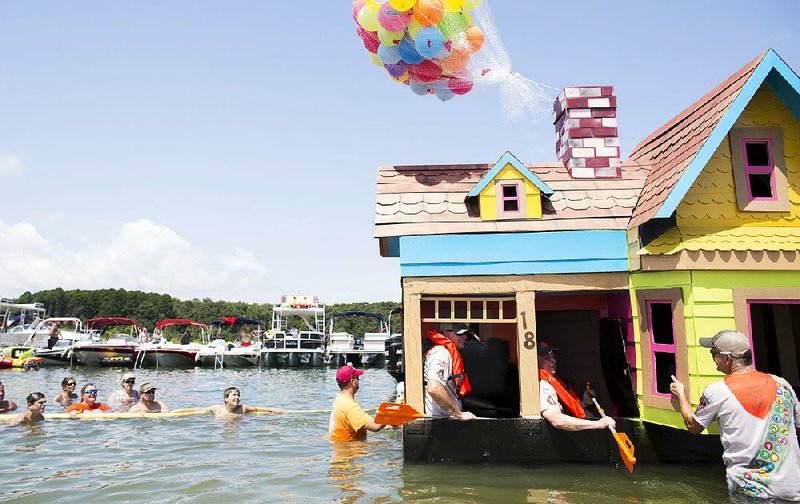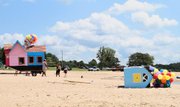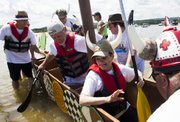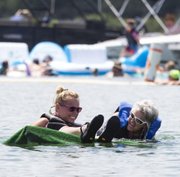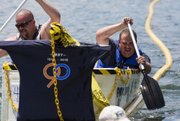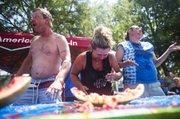HEBER SPRINGS -- On a Saturday morning in late summer, at a quasi-diner attached to a gas station about 10 minutes out from Heber Springs, three old-timers and one young buck eat biscuits with gravy and discuss bees.
"You mean you got 10 gallons of honey? Two full five-gallon buckets?" the buck exclaims. "How many hives you got?"
The old-timers wear jeans and thin denim shirts. The buck wears an oversize cowboy hat and a pearl-buttoned top. He seemed like a poser until he opened his mouth, freeing twangy syllables.
Nothing indicates that just up the road, more than 2,000 people are gathering.
[GALLERY: 2016 World Championship Carboard Boat Races]
Thirty years ago, a Chamber of Commerce president and local newspaper publisher decided that Heber Springs needed an annual tourist event. Inspired by the 40,000-acre Greers Ferry Lake, they organized the first World Championship Cardboard Boat Race. Competitors would build boats of cardboard, paint and perhaps duct tape and Liquid Nails and race them on the lake. At the end, any boats that didn't sink could take part in the Demolition Derby. They'd all slam into one another at once, in an effort to sink the competition.
The first cardboard boat race (on record) was in 1962, the result of a course assignment by Davis Pratt, a design professor at Southern Illinois University at Carbondale. There's no official count, but now there are at least a dozen in the United States, including a Maumelle Area Chamber of Commerce-sponsored Fourth of July race in Maumelle, a staff-sponsored Tender Loving Care Early Learning Center race in Searcy and a New Jersey race where boats take on the Atlantic.
THE COMPETITORS
By 9 a.m., competitors cluster on Sandy Beach, and spectators set up lounge chairs under big trees. Blue dragonflies swoop low, the scent of tanning oil collides with that of hot dogs, and shaved ice vendors hawk nontraditional breakfasts. There is no qualifying event for the 24 adult teams and the eight 12-and-under teams, nothing to indicate that the World Championships are championships in anything other than name.
Zach Mayer, 17, his brother Nick, 14, and their friend Harrison Hester, 14, are racing on behalf of the Little Red River Foundation. Their boat, made a decade ago out of an old refrigerator box, is white with stenciled fish, referencing the foundation's conservation work. Zach and Nick plan to race, and Nick and Harrison say they're doing the demolition derby.
"It's been in three derbies and won every time!" Nick says. This means dozens of boats have tried relentlessly to flood and puncture their craft, and it has never succumbed.
The Mayer brothers have missed the last few races to attend a national shooting competition. This will be their first year in the adult division, but Nick expects to win first. "I've never won second!" he says.
Nearby, Chris Couples stands next to a roughly 10-foot brown octagon, crowned with a lump of brown fur. Chris, 39, and Jeannie Honea, 35, staff members at Heber Springs' Southridge Village Nursing and Rehabilitation Center, recall 2012, the year the center won Pride of the Fleet (essentially, "best overall") for an aloha-theme pontoon that carried six people and was nearly as big as a real pontoon boat.
The masthead for this year's less impressive model is a bear from Brave, in keeping with the event's Pixar theme. Its Chris' ninth boat. None have sunk, but one year, his log cabin got stuck. "Someone got the bright idea to tow a cardboard outhouse behind it and when it fell over, it was like an anchor," he says.
That boat took six weeks of afternoons to make. The Brave boat was made in two weeks, with five sheets of cardboard on the bottom and three on the sides. Chris is sad that there's no demolition derby in its future, but he understands why this year there will be a "finale" instead, where all the boats race at once.
"You were supposed to be slamming your boats into each other, but people started using the paddle rather than the boat," he explains. (The Little Red River Foundation team must have missed the memo.)
There are three different houseboats paying homage to the movie Up. The most impressive was created in Oklahoma, by employees of a company headquartered in Wisconsin, using cardboard made from Arkansas trees. Green Bay Packaging has been entering teams for four
years. Often they win Pride of the Fleet, which seems unfair since they build things out of cardboard for a living. But then, these are the World Championships.
Green Bay's house is 12 feet tall, 9 feet long, 10 feet wide and weighs more than 300 pounds. It rode by transport truck from the factory in Tulsa on a post-woodchip-dump trip back to the mill in Morrilton. It's nearly identical to the movie's house, with eaves, framed windows and a roof tiled with individual pieces of cardboard. Above the roof, 125 balloons float en masse.
"I did the math. I think those balloons might lift 35 pounds?" says designer Jeff Brane, 42.
The bottom is double-layered, the walls are single-layered, and the whole thing is covered with glue and varnish.
The tiniest boat, Chicken of the Lake, has nothing to do with Pixar. According to its creator, Grace Story, 26, it's a play on Jessica Simpson's 2003 confusion on the show Newlyweds. Simpson wanted to know was Chicken of the Sea chicken or tuna?
Grace participated in the race twice as a child, but she has lived in Kansas for more than a decade. Built in three hours, her boat is less than 3 feet long and weighs about 10 pounds.
THE RACE
At 10 a.m., the boats in the first heat line up at the water's edge. There's a green, professional-looking cardboard canoe with a blow-up Googly Bear at the prow (Monsters Inc.) and a simply designed Lightning McQueen from the movie Cars. Spectators wade to the PVC-pipe lane marker, fancy cameras and cellphones held high.
Candice Corbit, 10, and her cousin, Peyton Sample, 9, are powering Lightning McQueen, built by Peyton's father. Candice worries that they'll sink, and Peyton feels sick to his stomach. They've never even seen a cardboard boat race, and now they have to kick off the World Championships.
Peyton says he has never paddled anything, but Candice corrects him -- "Remember when we went canoeing?"
Peyton wins the dice roll, so he gets to choose which lane. "Inside!" he crows. "I've rode go-karts enough to know that!"
A popgun fires and they're off. Or rather, Googly is off, heading forward at a steady pace.
Peyton and Candice paddle furiously, but they're inching along, pointed sideways. Then they're turning in balletic circles.
By the time Googly crosses the finish line, Lightning McQueen is only a third through the course. People on real pontoon boats yell, "Go baby, go baby, go!"
Lightning McQueen moves a little faster now but unfortunately, it's headed back to the start. A referee on a personal watercraft glides up, nudging it in the right direction. When it has completed two-thirds of the course, the referee gives them a tow.
Second heat: The popgun fires and they're off.
Except, they're not.
A Batmobile bends near the prow, taking water quickly. Volunteers rush to pull the vessel ashore.
Little known fact: Cardboard magically becomes cement when wet.
A pink boat labeled Princess makes steady progress, but the youngest member of the Batmobile crew, a boy of about 7, isn't interested. He happily floats on his back, still wearing his bat ears.
His partner, a boy of about 12, stands beside the shipwreck with a desolate expression. (Soon sinking will become so common that each time, a pontoon boat will blare, "Another One Bites the Dust." But it's hard to be first.)
When Princess is nearly at the finish, it rocks, tilts and then two girls tumble into the water. The desolate Batman looks up, slightly cheered, as the referee swoops to their rescue.
A pontoon boat plays Little Big Town's "Pontoon," and a little boy dances in the shallows, sticking out his tailbone and purposely knocking his friend over backward.
THE WATERMELONS
On the beach, there's a volleyball tournament and an ongoing watermelon-eating contest. Seven kids line up, lean over and shove their faces in Cave City melons. One tall boy lifts his melon to his mouth and shoves his face in. A small boy keeps glancing up, his cheeks full, his expression panicked. As soon as the finish whistle sounds, a stream of watermelon pours from his mouth like a faucet.
But Caitlin Carlton, 11, and Sarah Abbott, 10, continue to munch their melons after the whistle.
Caitlin is a seasoned competitor. "I've done this for some years now. When we first heard about this, we came here and I heard 'watermelon!' I've always loved watermelon," she says.
Both girls swallowed seeds, even though Sarah's grandmother told her not to. "I just ate it like a dog," Sarah says.
"What I do, I grab the watermelon. I try to stuff as much in my mouth, and once I have a lot of it, I start to swallow it. I don't recommend every kid doing that, because they can choke. I started coughing, she started coughing," Caitlin says, nodding at Sarah. "My grandmother, she gardens, so she gives us watermelons to eat, and my grandfather, he's diabetic, so he gets watermelons to eat ...."
Sarah cuts her off. "Are they ever gonna tell us who won?" She doesn't think she won, because she had the biggest slice, but she's eager to know who did.
THE HEAT
It's nearly noon and 100 degrees. Angela and Danny Carson of Sherwood are battling an Upside Down boat in the tightest heat of the day. They're in Dusty Crophopper from Planes, because last year Angela's Uncle Sam attended this race and since then, he has passed on.
"Planes was his favorite movie to watch with his grandkids," Angela, a physical therapy assistant and baker, had explained earlier in the morning. "It's not a Pixar movie, but it was produced by the Pixar executive, so I was like, 'Close enough.'"
When they finally hit the shore, Danny doubles over. "Did we win?" he gasps.
The announcer decides the heat is too close to call.
THE ELDERS
The Mormon elders watch from shore. At 19, they're not that old, and they have real names, but they won't give them. They must be melting in their identical black suits. Elder Lambson wears a SpongeBob SquarePants tie.
"When we're on our mission, we go by 'elder,'" says Elder Goasling of New Mexico.
"This is pretty sweet," says Elder Lambson of Utah. He has never seen a cardboard boat race before.
THE HOUSES
A tiny Up house manned by four teenagers from New Life Church races the gigantic house, beating it by 20 feet.
"We put carpet tubes between the layers of cardboard to give it some strength and height," say Chuck Jeffcoats, 32, who oversaw construction. His crew laugh, embrace and high-five. They were so fast, they wonder if they'll win fastest overall.
A third Up house has fallen off its cardboard platform, where it once teetered atop stilts. The crew abandons the house on the beach and races the second heat with just the platform (boats can race twice and take the best time).
By the end of the heat, the platform is disintegrating. Five women try unsuccessfully to tug the soggy mess to shore. "First we lost the house. Then we lost the boat," one of them jokes.
THE UPDATE
Brave sinks immediately. For Southridge, there is nothing dignified about reaching double-digits.
Chicken of the Lake weaves from side to side, but it finally bumps to shore. Grace steps out, panting. "I was so slow. Was I slower than everyone? ... And I'm not doing it again. That was exhausting." (Five minutes later, she's talking about the second heat. Her cardboard tuna can survives that, too.)
THE END
At 2 p.m., the announcer switches the public address system to a radio station. Unfortunately, the station is in the midst of a news broadcast about a lethal balloon crash in Texas, terrorists in Belgium, the possibly targeted killing of a California police officer and high school boys kicked off their football team for hazing. Mercifully, the broadcast cuts to a commercial.
And anyhow, people don't seem to notice. They're tired, dehydrated and excited as they head to the pavilion for the awards ceremony.
The Dassault Falcon corporate teams sweep the speed awards, as they have most of the 28 years they've competed. (Turns out, Googly Bear is a Falcon boat.) But that doesn't mean Nick Mayer wins second. The Little Red River team has the fastest time of all of the two-person crews, maybe because Falcon doesn't have any two-person crews.
Green Bay Packaging's Up wins Pride of the Fleet, and the World Championships are over. It's time for everyone to disperse to Heber Springs restaurants.
ActiveStyle on 08/15/2016
